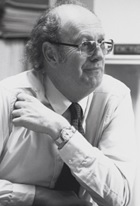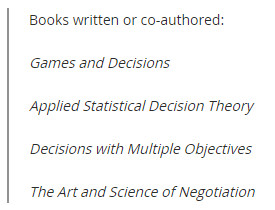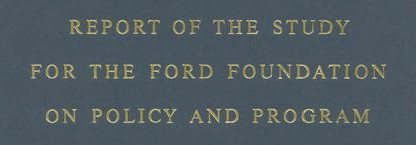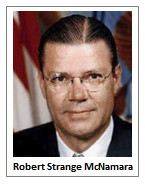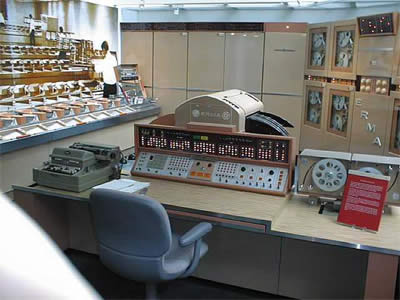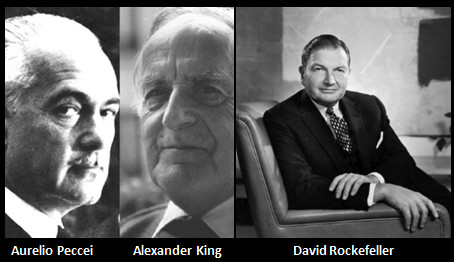
Outstanding research and detail from Vicky Davis at The Technocratic Tyranny blog. Some essential history and background on where we are today and how we got here:

By: Vicky Davison: August 01, 2019
On July 8, 2016, Howard Raiffa died in his home in Tucson Arizona at the age of 92 years. While a professor at Harvard University, Raiffa and his colleagues created a new field of economics and they established an MBA program for it. The field was called Managerial Economics.
Raiffa came to Harvard Business School in 1957, “one of a small cadre of discipline-based scholars imported into this School,” in Dean Clark’s words, “through the generosity of the Ford Foundation, as part of a larger movement to broaden the intellectual base of business schools nationwide.” The experiment worked. Raiffa had found a lifelong home at Harvard University…although Raiffa had had no experience in business, he was “vitally interested in how systematic thinking could help decision making.”
“…he helped advance the fields of game theory, decision theory, and negotiation analysis… Raiffa’s work, which was global in nature, spanned both public and private sector decision-making issues and included a deep interest in complex problems involving not only management but government policy, science policy, public health, and clinical medicine.”
He inspired generations of academics at HBS, at Harvard (notably the Harvard Kennedy School), and the world at large, for example by bringing East and West together at the International Institute for Applied Systems Analysis (IIASA), the organization he helped found in Austria.
Ford Foundation Redefines Philanthropy
H. Rowan Gaither was hired by the Ford Foundation in 1947 to define a post-war mission for the Foundation. Gaither formed and directed a committee for the project. In 1949, they published the Report of the Study for the Ford Foundation on Policy and Program stating their mission and objectives. In the introduction, they state very clearly that they were moving beyond the traditional bounds of a philanthropic organization toward social engineering of the society. Unstated but implicit is that they were moving into the political arena because by definition, changing society is in every sense of the word, political.
Gaither became president of the Foundation in 1953 and served in that position through 1956. He became Chairman of the Board in 1956.
H. Rowan Gaither
Between 1952 and 1954, there were two congressional committees investigating un-American Activities of tax-exempt foundations. Norman Dodd was the chief investigator for the Reese Commission to investigate foundations. H. Rowan Gaither was the Associate Director of the Ford Foundation when he testified before the committee on November 24, 1952.
RAND, Inc.
RAND was established as a project under contract to the Douglas Aircraft Company in 1945. Major General Curtis LeMay was appointed to be the Deputy Chief of Air Staff for Research and Development. When Rand was spun off from Douglas, H. Rowan Gaither was retained as legal counsel to determine the best means of setting up Rand as an independent corporation.
From the History page of RAND:
Excerpts from RAND’s History
In May 1946, Project RAND released its first report, Preliminary Design of an Experimental World-Circling Spaceship, which discussed the potential design, performance, and use of manmade satellites. A year later, Project RAND moved from the Douglas plant to new offices in downtown Santa Monica. Project RAND also held a symposium in New York as a first step in enlisting social scientists for the organization.
… In February 1948, the Chief of Staff of the newly created United States Air Force wrote a letter to the president of the Douglas Aircraft Company that approved the evolution of Project RAND into a nonprofit corporation. Douglas. H. Rowan Gaither, Jr., a prominent San Francisco attorney who later served as president and then as chairman of the board of the Ford Foundation, was retained as legal counsel to determine the best means of setting up an independent RAND.
On May 14, 1948, RAND was incorporated as a nonprofit corporation under the laws of the State of California. The articles of incorporation set forth RAND’s purpose in language that was both remarkably brief and breathtakingly broad:
To further and promote scientific, educational, and charitable purposes, all for the public welfare and security of the United States of America.
…In his 1996 doctoral dissertation (PDF) examining RAND’s early years and the broadening of its research agenda, historian David Jardini of Carnegie Mellon University compiled an exhaustive list of contributions by RAND researchers, showing a reach that went far beyond assistance to military decisionmakers. These contributions include significant achievements in space systems, providing the foundation for America’s space program, and important contributions to digital computing and artificial intelligence. (Researcher Paul Baran’s work on packet switching, for example, provided the building blocks for today’s Internet technology, and RAND staff designed and built one of the world’s earliest computers.) RAND researchers also developed theories and tools for decisionmaking under uncertainty, and they made foundational contributions to game theory, linear and dynamic programming, mathematical modeling and simulation, network theory, and cost analysis.
Jardini singled out for special recognition a methodological approach called systems analysis, which provides information to military decisionmakers designed to “sharpen their judgment and provide the basis for more informed choices.” As RAND’s scope evolved and broadened, Jardini noted,
systems analysis served as the methodological basis for social policy planning and analysis across such disparate areas as urban decay, poverty, health care, education, and the efficient operation of municipal services such as police protection and fire fighting.
Robert Strange McNamara
Robert S. McNamara was appointed to the position of Secretary of Defense in 1961. McNamara got his undergraduate degree in economics from UC Berkeley. He then went to Harvard Business School to learn management techniques. From the Encyclopedia Britannica:
During World War II, “he developed logistical systems for bomber raids and statistical systems for monitoring troops and supplies. After the war, McNamara was one of the “Whiz Kids” hired to revitalize the Ford Motor Company. His plans, including the institution of strict cost-accounting methods and the development of both compact and luxury models met with success, McNamara rose rapidly in the corporate ranks. In 1960 he became the first person outside the Ford family to assume the presidency of the company.
After only a month as President of Ford Motor Company, JKF appointed McNamara to be the Secretary of Defense to lead a project of modernization of the Defense Department.
McNamara brought the methods of Systems Analysis to the project of reorganization and restructuring of Defense. In McNamara’s biography on the Defense Department’s website includes the following:
The most notable example of systems analysis was the Planning Programming Budgeting System (PPBS) instituted by DoD Comptroller Charles J. Hitch. McNamara directed Hitch to analyze defense requirements systematically and produce a long-term, program-oriented Defense budget. PPBS evolved to become the heart of the McNamara management program. According to Enthoven and Smith, the basic ideas of PPBS were: “the attempt to put defense program issues into a broader context and to search for explicit measures of national need and adequacy”; “consideration of military needs and costs together”; “explicit consideration of alternatives at the top decision level”; “the active use of an analytical staff at the top policymaking levels”; “a plan combining both forces and costs which projected into the future the foreseeable implications of current decisions”; and “open and explicit analysis, that is, each analysis should be made available to all interested parties, so that they can examine the calculations, data, and assumptions and retrace the steps leading to the conclusions.”
Alain C. Enthoven was one of McNamara’s Defense Department “Whiz Kids” who was involved in the project of redesigning the Defense Department systems. In 1971, he along with K. Wayne Smith produced a book about the experience of applying Systems Analysis techniques to the process of organization and management of military and defense assets and processes. The title of the book is How Much is Enough? Shaping the Defense Program, 1961-1969. Rand made the book available on their website. In the book, the authors try to answer the question: What is Systems Analysis?
(Fair Use for Educational Purposes only) Pages 91-92:
What is systems analysis? Like sin and virtue, systems analysis means different things to different people. In the world of industry, it is used to describe many different kinds of jobs. Many universities offer courses in systems analysis, but few courses are alike. There are several books on systems analysis, but they discuss largely different things.15 Moreover, few if any of these jobs or courses or books bear much resemblance to systems analysis as it was developed and used in the Department of Defense.
The term itself emphasizes two basic aspects of thinking about defense problems. First, the word “systems” indicates that every decision should be considered in as broad a context as necessary. In most cases, decisions deal with elements that are parts of a larger universe, or system. Good decisions grow out of a recognition that each element is but one of a number of components working together to serve a larger purpose…Systems analysis emphasizes the explicit consideration of all factors that bear on a particular decision in terms of the system these factors together constitute.
The word “analysis” emphasizes the need to reduce a complex problem to its component parts for better understanding. Systems analysis takes a complex problem and sorts out the tangle of significant factors so that each can be studied by the method most appropriate to it. Questions of fact can be tested against the available factual evidence; logical propositions can be tested logically; matters of value and uncertainty can be exposed and clarified so that decision makers can know exactly where to apply their judgment…
Systems analysis is a reasoned approach to highly complicated problems of choice in a context characterized by much uncertainty; it provides a way to deal with differing values and judgments; it looks for alternative ways of doing a job; and it seeks, by estimating in quantitative terms where possible, to identify the most effective alternative. It is at once eclectic and unique. It is not physics, engineering, mathematics, economics, political science, statistics, or military science; yet it involves elements of all these disciplines. It is much more a frame of mind than a specific body of knowledge, which explains why economists, physicists, military officers, and liberal arts graduates can all be good systems analysts-or bad ones, for that matter. A good systems analyst is a relentless inquirer, asking fundamental questions about the problem at hand.
In other words, it’s a way of thinking – a methodology for problem solving that involves breaking the problem down into manageable pieces, examining them logically, testing different hypotheses to select the best solutions within the constraints and then putting the pieces back together to solve the problem in a logical and more efficient way. It’s a fabulous tool for business processes such as Ford’s assembly lines for the production of cars. The social engineers however, began applying the techniques to the society at large as if people are just objects to be moved around on the chess board like pawns. Since most people are not willing objects, that’s where game theory and the manipulation of perception comes into play (no pun intended).
Would You Believe?
The social engineers design the solutions to societal problems they would like to see implemented and then they have to manufacture consent through the manipulation of perception. That involves making the public aware of a problem (real or created), anticipating the reaction and then offering the pre-determined solution that is an element in the design. It’s a cakewalk as long as the solution corresponds to the problem. An obvious example of discord between the problem and the solution is gun control. It doesn’t matter how many engineered shooting events occur, the public’s response is to have more guns in the hands of law-abiding citizens thereby defeating the dialectic.
Most people are completely unaware of the engineering behind the “reform” proposals offered by politicians. Interestingly, Alain Enthoven gives us a perfect example of an engineered solution to a problem that was probably the biggest public policy failure in the history of our country. Of course that would be Hillary Care – renamed to be Obama Care “reform” of the health insurance market by implementing managed competition (with subsidies) as a solution to the high cost of health care.
In 1993, Alain Enthoven wrote a paper titled, The History and Principles of Managed Competition for government management of the health insurance market behind the facade of the health insurance business of the private sector. In simple terms, the government subsidies between taxpayer A and non-taxpayer B would occur behind the wall of a national system they called the health insurance “market place”. Everybody would buy insurance from an insurance carrier but the subsidization would occur between the government and the insurance carriers.
Enthoven’s paper and an analysis of the idea can be read HERE. And the selling of the idea to the public can be read about HERE including links to recordings as well as links to the C-Span program where the presentation was made. Notice how the public is given only This Choice or That Choice. The public can choose prosperity now and into the future or they can choose disaster. That’s social engineering, manipulation of perception and manufacturing consent.
Social Engineering by Carnegie
President John F. Kennedy was assassinated in November of 1963. Shortly after Lyndon Baines Johnson was sworn in as the President, he announced the plan for a Great Society. The Great Society was the umbrella name for a large package of social engineering programs designed to change the character and nature of America. LBJ appointed John W. Gardner to be the Secretary of Health, Education and Welfare (HEW) in 1965. At the time, Gardner was President of the Carnegie Foundation. He is considered to be the Architect and Engineer of the so-called Great Society.
John W. Gardner
Gardner graduated from Stanford University in 1935 with a degree in psychology. In 1938, he received his Ph.D in psychology from UC Berkeley. He taught psychology at the Connecticut College for Women. Nurturing human potential was a consuming interest for Gardner.
When World War II started, Gardner moved to Washington DC to analyze enemy propaganda broadcasts to Latin America. In 1943, he joined the Marines and the Office of Strategic Services (OSS). (After the war, the OSS became the CIA.) Source: PBS Profile and Timeline of the life and career of John W. Gardner.
A video produced by the History Channel was found on youtube. Ignore the enthusiastic endorsement, just focus on the subject areas of the programs and the number of programs. Clearly Gardner was establishing the framework for social engineering the American population.
The Futurists
Throughout the 1940’s and 1950’s scientists were working on building computers to solve complex mathematical problems. In the mid 1950’s Bank of America partnered with the Stanford Research Institute to develop a machine to help manage their bank accounts with the main feature being magnetic ink on the checks that could be machine read. By 1959, the computer was operational and the Information Age was born.
We were on the threshold of what would become a revolution in the way that business functioned and the way we live our lives. Enter the Futurists –
In a book titled, Toward the Year 2000, Daniel Bell recounts the history of the field of futurism:
In 1965, the American Academy of Arts and Sciences initiated the Commission on the Year 2000, the forerunner of what became the field of futurism. The Commission did not believe that one could “predict” the future, but sought instead to identify structural changes in society that would have long-term social impacts. And since the Commission believed that choices were possible, it sought to chart “alternative futures” on critical issues that society would face.
That’s a perfect setup for social engineering the public. And that’s what the futurists did. They sculpted narrative visions of the future with clear cut choices. A or B. This or That. Utopia or Apocalypse.
To get funding for the Commission on the Year 2000, Daniel Bell went to see John W. Gardner of the Carnegie Foundation. In 1966, TIME magazine published an essay about the Futurists titled: The Futurists: Toward A.D. 2000 (emphasis added)
The exploration of the future has become a sizable business. General Electric has set up Tempo (Technical Management Planning Organization) in Santa Barbara, where 200 physical scientists, sociologists, economists and engineers contemplate the future on a budget that tops $7,000,000 a year. The armed forces have long been in the future business. The Air Force, at Wright-Patterson A.F.B., conducts studies of the whole problem of scientific prediction, also contributes $15 million a year to Santa Monica’s Rand Corp. to think—and not necessarily about weapons systems. The nonprofit Hudson Institute investigates the possibilities of war and peace along with the future in general.
At the University of Illinois, Dr. Charles Osgood is conducting a “computerized exploration of the year 2000,” and the Southern Illinois University is providing money and facilities for Buckminster Fuller’s World Resources Inventory. The American Academy of Arts and Sciences helps to support the Commission on the Year 2000, headed by Columbia Sociologist Daniel Bell. The Ford Foundation has allocated $1,400,000 this
year to a group called Resources for the Future, also supports a Paris-based organization, headed by Veteran Futurist Bertrand de Jouvenel, whose studies are known as “Les Futuribles.”
Forecasting is an art that still has few textbooks. Its basic tool is extrapolation from yesterday and today. As John McHale, executive director of World Resources Inventory, puts it: “The future of the future is in the present.” Some other methods seem fairly arcane. Defense Expert Herman Kahn, for instance, uses “scenario writing,” in which various alternative future situations are dramatized. Some forecasters use computers to produce a symbolic “model” of particular social or economic structures—including whole industries or nations—and then simulate the interaction of variables. Rand uses the “Delphi” method, in which a wide range of experts are queried and re-queried for their forecasts, arriving finally at a near-consensus. Prognosticators concede that the timing and nature of pure inventions or basic breakthroughs—such as the achievement of atomic fission—are not predictable. In many cases, they must still rely on “imaginings.”
Part 2 – Rockefeller and the Club of Rome








